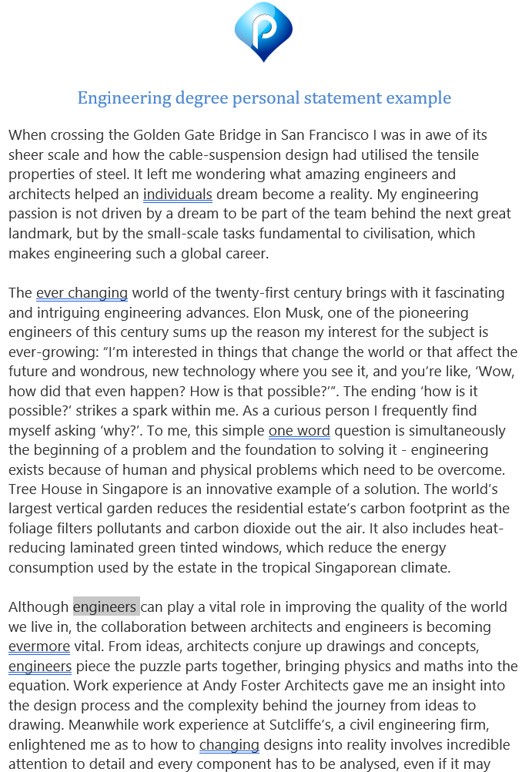- Reading time: 3 minutes
- Price: Free download
- Published: 30th October 2021
- Price: Free download
- Word count: 697 words
- File format: Text
Preview:
When crossing the Golden Gate Bridge in San Francisco I was in awe of its sheer scale and how the cable-suspension design had utilised the tensile properties of steel. It left me wondering what amazing engineers and architects helped an individuals dream become a reality. My engineering passion is not driven by a dream to be part of the team behind the next great landmark, but by the small-scale tasks fundamental to civilisation, which makes engineering such a global career.
The ever changing world of the twenty-first century brings with it fascinating and intriguing engineering advances. Elon Musk, one of the pioneering engineers of this century sums up the reason my interest for the subject is ever-growing: “I’m interested in things that change the world or that affect the future and wondrous, new technology where you see it, and you’re like, ‘Wow, how did that even happen? How is that possible?’”. The ending ‘how is it possible?’ strikes a spark within me. As a curious person I frequently find myself asking ‘why?’. To me, this simple one word question is simultaneously the beginning of a problem and the foundation to solving it – engineering exists because of human and physical problems which need to be overcome. Tree House in Singapore is an innovative example of a solution. The world’s largest vertical garden reduces the residential estate’s carbon footprint as the foliage filters pollutants and carbon dioxide out the air. It also includes heat-reducing laminated green tinted windows, which reduce the energy consumption used by the estate in the tropical Singaporean climate.
Although engineers can play a vital role in improving the quality of the world we live in, the collaboration between architects and engineers is becoming evermore vital. From ideas, architects conjure up drawings and concepts, engineers piece the puzzle parts together, bringing physics and maths into the equation. Work experience at Andy Foster Architects gave me an insight into the design process and the complexity behind the journey from ideas to drawing. Meanwhile work experience at Sutcliffe’s, a civil engineering firm, enlightened me as to how to changing designs into reality involves incredible attention to detail and every component has to be analysed, even if it may seem trivial. Global challenges such as water scarcity, carbon and greenhouse gas emissions as well as global warming are becoming evermore prevalent in today’s world. With last summer being the combined hottest summer on record for Britain and hurricanes of ever increasing quantity and severity in the North Atlantic since the 1980’s it is clear the world is changing at a tremendous pace.
Sustainability as well as green and zero energy design needs to become a focus at the heart of engineering to overcome such challenges. Recently Tesla changed their mission statement to “to accelerate the world’s transition to sustainable energy”, indicating how engineers like Musk are aware of how they are a key factor in driving change. My curiosity and passion about making Earth a greener place through engineering, was the drive behind my Extended Project titled ‘To what extent should biomimicry be applied to the man-made world as a method to tackle global challenges?’. Completing a MOOC on Modern Building Design, where I was introduced to new innovative building techniques, in addition to reading ‘The Gecko’s Foot’ which explores the concept of biomimicry, were two of the main factors inspiring my EPQ. From how the Eastgate Centre in Harare uses natural conditioning, inspired by the design of termite mounds, to maintain a comfortable indoor climate in the arid African heat, to the beetles of the Namib Desert which can procure water from fog, inspiring the design of a bottle allowing remote communities living in arid foggy lands access to clean drinkable water.
In 2018 I was awarded the Lord Lieutenant’s Certificate of Merit. This hugely proud moment was the end result of a process including guide leadership, coaching karates and an independently organised volunteering trip to the Galápagos Islands. My ability to manage a large number of commitments coupled with my academic ability means that I am well placed to fully engage in the study of engineering at university.
Related personal statements:
- Renewable Energy Systems MEng Personal Statement Example
- Urban Planning BSc (Hons) Personal Statement Example
- Aerospace Engineering BEng Personal Statement Example
- Architectural degree personal statement (6)
- Aeronautical / Astronautical Engineering Personal Statement
- Civil engineering personal statement example
- Mechanical Engineer Personal Statement Example Personal Statement
- Engineering Personal Statement Examples
- Construction Management Masters personal statement
- Architecture personal statement (5)
Review this personal statement:
Latest reviews:
There are no reviews yet. Be the first one to write one.
